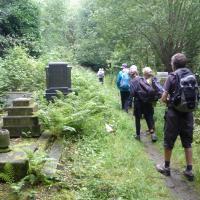 Today we stayed local for visits to two contrasting sites.
Today we stayed local for visits to two contrasting sites.
We started at Hirst Wood Burial Ground, gathering in the gloom of the wooded burial ground adjacent to Nab Wood Cemetery. BEES Friday volunteer group have been involved in some management of the site over the past couple of winters, so I wanted to return in the summer to collate a species list for the site, and get some ideas about the best way forward to implement the ecological management plan.
The land is owned by St Paul’s Church and managed by the Hirst Wood Burial Board. Since regular burials ceased in the 1980s, the site has developed into a woodland habitat which the Church recognise as offering value as natural green space and a space to pay respects and for contemplation. The recently devised management plan states the aim to sympathetically manage for both access to graves and support the ecology of the site.
It wasn’t long before we reached consensus that the site would benefit from opening the canopy in some areas. Although it was overcast, it was clear that there were only small patches where the sun penetrated to the ground. We know that there is an idea to fell some of the large willow, subject to a tree preservation order application and finding resources to employ a tree surgeon. Today’s visit supported this aspiration.
Typical of a shady understory, we saw a lot of ferns; Lady, Male, Broad Buckler, Hard and Hart’s Tongue Ferns. There was a lot of Wood Dock, Bramble and Wood Avens, and carpets of Ivy. There is quite a mix of tree species with some notably large elm trees. The woodland below the terraced burial ground had the roughly the same mix of species, with the notable addition of Common Cow-wheat. The ground flora was fairly sparse, understandable under the mature Sycamore, Ash and Oak, except in the wet flushes. There were Sparrowhawks in the canopy, including noisy youngsters.
Once we found the exit through to the housing estate, the group made their way to Hirst Lock for lunch (while I drove the minibus round to Coach Road). Amazingly considering the forecast, our only soaking of the day was at lunch time, but the bird hide in the Hirst Wood Nature Reserve and Higher Ground café offered shelter.
We reconvened in the Nature Reserve/Community Garden where the focus of our attention was on a Southern Hawker laying eggs in moss covering a rock at the side of the pond platform. The butterflies were enjoying the mix of wild species and domesticated plants.
A short walk crossing the canal and river and past the houses took us (well some of us - lunchtime saw the start of people peeling off at intervals during the afternoon) to Trench Meadow; one of only two SSSIs in the Bradford District. It was a total contrast to the morning; the sun was out (a rare occurrence on a BEES’ trip to Trench Meadow!) and this is a flower-rich grassland with the influence of woodland at the edges.
We were a little early in the summer to enjoy the full display of the Devil’s-bit Scabious, but the first few flowers were opening. The purple flowers on offer today were swathes of Betony and Knapweed, with a little dash of Greater Burnet. The insects were loving them all and we had a good afternoon of butterflies and moths including Peacock, Small Skipper, Small Copper, Gatekeeper, Meadow Brown and Silver Y. The most numerous were the Green Veined Whites and the Painted Ladies, but for me the most exciting was the White Letter Hairstreak. This is only the second time I have seen one. It was feeding on Common Ragwort at the top of the meadow along with many other insects, a good example of how valuable this plant is in the ecological mix.
Our botanising exploits in the afternoon were aided by the very welcome arrival of Joan. Other plants included Common and Sheep Sorrel, Hoary Willowherb, Common Centaury (in seed), Mouse-ear-hawkweed, Common Spotted Orchids, just about over, Greater Bird’s-foot Trefoil, Creeping Cinquefoil and Marsh Ragwort. We found a single spike of Marsh Arrowgrass alongside the the main damp flush, and there were few more extensive patches of Marsh Pennywort.
As the skies darkened, we made a retreat to the minibus and had just started our return journey when the torrential rain started. A contrasting day, I think. Thanks for the comments about the HWBG, I will feed them back to the managing Board, along with the species list.
See some pictures from the day in the gallery
Julia
